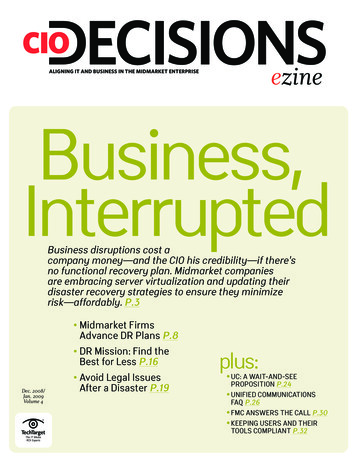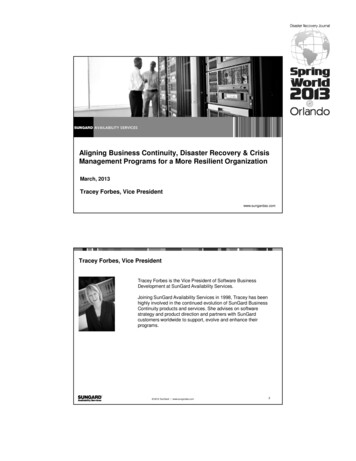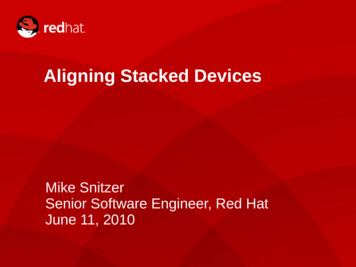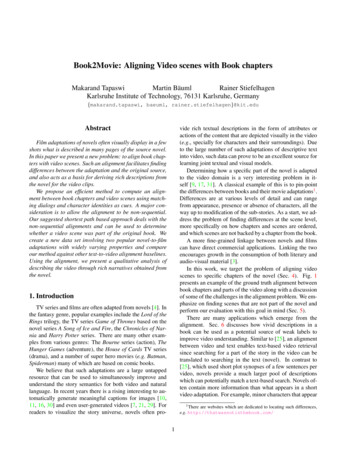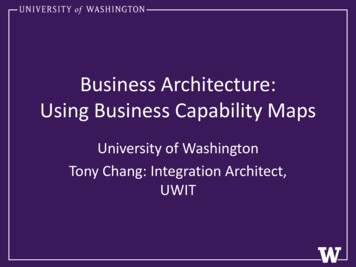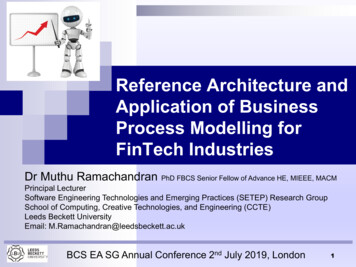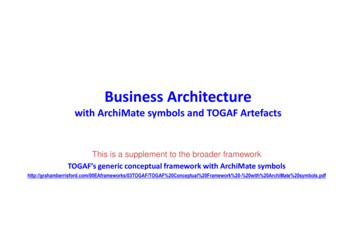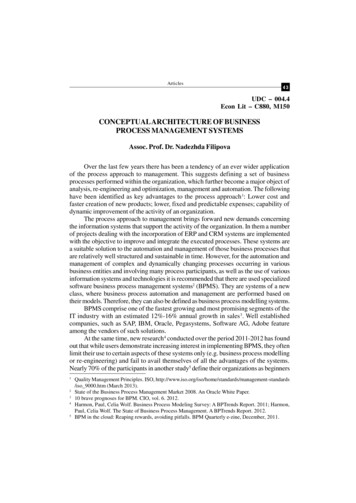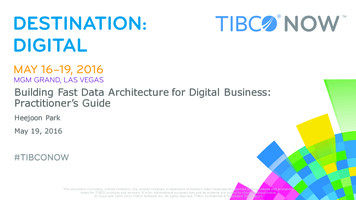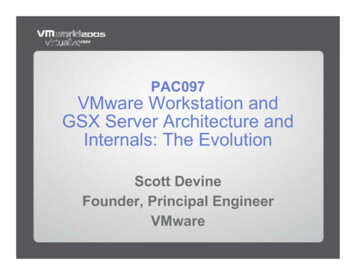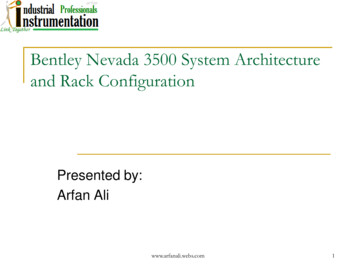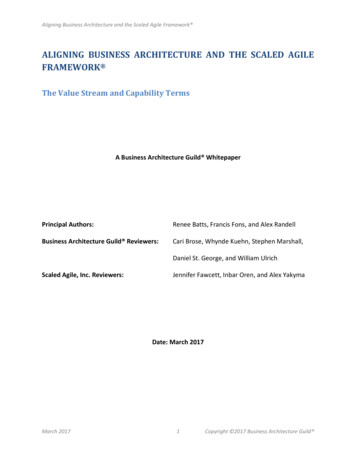
Transcription
Aligning Business Architecture and the Scaled Agile Framework ALIGNING BUSINESS ARCHITECTURE AND THE SCALED AGILEFRAMEWORK The Value Stream and Capability TermsA Business Architecture Guild WhitepaperPrincipal Authors:Renee Batts, Francis Fons, and Alex RandellBusiness Architecture Guild Reviewers:Cari Brose, Whynde Kuehn, Stephen Marshall,Daniel St. George, and William UlrichScaled Agile, Inc. Reviewers:Jennifer Fawcett, Inbar Oren, and Alex YakymaDate: March 2017March 20171Copyright 2017 Business Architecture Guild
Aligning Business Architecture and the Scaled Agile Framework ALIGNING BUSINESS ARCHITECTURE AND THE SCALED AGILEFRAMEWORK IntroductionToday’s business environment demands sound decision making and quick follow through toaddress global competition and rapid market disruption. In response, more organizations seekproven frameworks to achieve agility, enabling them to remain competitive and innovative. Thedrive to realize these goals has given rise to increasing interest in both business architecture andthe ability to coordinate disparate agile teams using scaling techniques for agile, such as theScaled Agile Framework (SAFe ).Both approaches desire the same outcome: increased organizational agility and delivery of realbusiness value. However, there is a very important challenge facing organizational leaders usingthese frameworks: both frameworks have identified key terms, but they do not define theseterms in exactly the same manner. This white paper strives to achieve clarity by reconcilingdifferences between SAFe and business architecture definitions.The business architecture discipline has quickly developed and matured over the last decade. TheBusiness Architecture Guild (Guild) has led the development of best practices and blueprints tobridge the gap between strategy formulation and solution delivery. The business architectureapproach matured through the establishment of a standard framework, codification of bestpractices via a body of knowledge, certification program, and an emerging metamodel standard.The Guild maintains A Guide to the Business Architecture Body of Knowledge (BIZBOK Guide)with at least two releases per year and publishes related content via white papers and webinars,including substantial work related to business architecture and agile methodologies.1Another recent development is the desire to implement agile approaches to groups larger thanan agile team. SAFe is the leading framework used to help organizations scale agile approachesand successfully manage multiple teams utilizing agile methodologies. One of the principaldesigners of the framework, Dean Leffingwell, noted in a January 31, 2016, blog that 60 percentof Fortune 100 companies in the United States have SAFe -trained practitioners. Case studiesindicate increases in quality of 50 percent and productivity of 20-50 percent, whilesimultaneously delivering software more quickly 30-75 percent of the time.21Elliott, Eric Shayne, Francis Fons, and Alex Randell. “Business Architecture and Agile Methodologies”. BusinessArchitecture Guild . Feb. 2015. Web.2Leffingwell, Dean. “5 Reasons to Consider SAFe ”. Scaled Agile Framework , Jan. 2016. Web.March 20172Copyright 2017 Business Architecture Guild
Aligning Business Architecture and the Scaled Agile Framework Overall AlignmentThe authors selected two focal points for this white paper: value stream and capability. However,in evaluation of both frameworks, there are clearly opportunities to continue aligning suchconcepts as strategic themes and strategies, epics and initiatives, portfolios of all kinds,stakeholders, and more. Additionally, both frameworks align with other related disciplines, suchas project management, requirements analysis, process management, case management, andmore. Business architecture provides a consistent framework upon which to view these conceptsand apply these disciplines. Through framework alignment and reconciliation of terms, SAFe canprovide a framework to implement these business-focused components and ultimately deliverbusiness value.The two terms this white paper substantially addresses are “value stream” and “capability”. Asdefined in SAFe , a value stream is a “long-lived series of steps that an enterprise uses to providea continuous flow of value to a customer”.3 The BIZBOK Guide defines value stream as an “endto-end collection of activities that deliver value to internal and external stakeholders”.4 The valuestream definitions may seem similar at a glance, but the nuances of how each organizationincorporates the terms are addressed in the next section.There is a larger discrepancy in the usage of capability. As defined in SAFe , capability describesthe “higher-level behaviors of a solution at the value stream level”.5 The BIZBOK Guide definesa capability as “what” a business does: “a particular ability or capacity that a business maypossess or exchange to achieve a specific purpose or outcome”.6 From this alone, the BIZBOK Guide suggests a consistent framework with uniqueness that describes a business in whole. Incontrast, the SAFe definition appears to leave room open for dynamic definition of a capabilitybased on usage. These differences are also explored and aligned in a subsequent section.Value Stream AlignmentAs noted earlier in this paper, business architecture provides a blueprint of the business. Muchlike an IT architect who identifies the systems, data, integrations, and resources required tomaintain an IT organization, business architecture identifies what the business does, how thebusiness provides value, the information required to do business, and the people, business units,and organizations involved.3“Value Streams”. Scaled Agile Framework , Apr. 2016. Web. Mar. 2017.Business Architecture Guild , A Guide to the Business Architecture Body of Knowledge , v5.5 (BIZBOK Guide),2016. Part 1, Page 85“Features and Capabilities Abstract”. Scaled Agile Framework , Apr. 2016. Web. Mar. 2017.6A Business-Oriented Foundation for Service Orientation, Ulrich Homann, Feb. 9368.aspx4March 20173Copyright 2017 Business Architecture Guild
Aligning Business Architecture and the Scaled Agile Framework The SAFe pattern identifies two value stream concepts that are in harmony with the businessarchitecture value stream concept; likely because architecture plays an important role in bothpractices. SAFe defines an operational and a development value stream. In the simplest terms,the operational value stream reflects the reason an organization is in business; it is how theorganization makes money. The development value stream is how the systems are architectedand implemented to support the value offering of the business. By definition, the SAFe operational value stream is synonymous with the business architecture value stream.Business architecture defines a value stream as an end-to-end collection of activities that createa result for a customer, who may be the ultimate customer or an internal end-user of the valuestream. Key elements of the business architecture value stream include identification of thetriggering and participating stakeholders, as well as the value proposition delivered by the valuestream, and incremental value items that accrue along the way to achieving the valueproposition. To put it simply, the business architecture value stream depicts the value beingsought and received — or, in other words, the reason a customer does business with anorganization.Turning back to SAFe , the operational value stream includes “steps used to provide goods andservices to a customer”. SAFe further defines an operational value stream as “containing thepeople who do the work, the systems they operate, and the flow information and material todeliver the value to the customer”.The business architecture value stream and SAFe operational value stream include the keyconcepts of people, organizations, information, and value delivery. These concepts are corecomponents of the business architecture framework, providing the basis for business blueprintswithin an organization that yield a common terminology and business context. The differencesthat may arise involve the focus business architecture places on a value stream that it bestakeholder triggered, represent a true end-to-end perspective and terminate when the valueproposition is achieved. With this understanding, it becomes clear that the concepts betweenSAFe and business architecture are in alignment, given that the above business architectureconstraints are recognized and enforced.The difference between the two practices resides in the SAFe ’s development value stream. Thedevelopment value stream is the way IT organizes itself around the business architecture valuestream. A development value stream is the operating model in how an organization is going touse the right people, systems, and data to develop the product, service, or capability that wouldbecome part of the future state business model.When aligning SAFe Agile Release Trains (ARTs) to value streams, it is critical to consider thebusiness architecture / operational value stream first, followed by the development valueMarch 20174Copyright 2017 Business Architecture Guild
Aligning Business Architecture and the Scaled Agile Framework streams to achieve the benefits SAFe offers an organization, including: A single backlog for a SAFe ART, managed by a product manager that has responsibilityfor prioritization and determination on epic inclusions and other stakeholder inputsBudget allocation by the SAFe ART and/or value stream, approved by leaders whodetermine which SAFe ARTs need additional resources or funding and which ones needless support based on periodic prioritization practicesWhen SAFe is implemented, the benefits achieved provide faster delivery of business value andthe ability to prioritize work across the organization, rather than by individual or siloed agileteams. Business architecture can provide a structure of existing value streams or help SAFe implementations identify value streams that are not yet articulated in the business architecture.Further upstream, business architecture helps leaders and strategists articulate businessstrategies, which SAFe implementations can leverage to identify strategic themes and budgets.Business architecture does not and should not, however, unilaterally determine SAFe ARTcomposition or epic/feature prioritization. There can be legitimate reasons for a train to take onwork not associated with its primary operational value stream(s). However, as the value offeredto a customer is not likely to change dramatically over time, the SAFe ART can become wellversed in the business context around the value streams, even if it is focused on delivering acomponent of a development value stream.Capability AlignmentWhile the alignment of business architecture and SAFe value streams is relatively consistent,with a few minor, semantic differences, the business architecture and SAFe concepts ofcapability require a bit more review and consideration. This is not to say these concepts aremisaligned or not in alignment but rather that the specific language requires practitioners ofSAFe and business architecture to consider their shared vocabulary more thoughtfully whenharnessing the power that can be gained by leveraging both frameworks.SAFe ’s implementation of capability, first found in version 4 of the framework, manifests itselfas a volatile element that release trains deliver. In this usage, the capability is not itself a lastingelement of the business framework but rather the manifestation of a business outcome.The first piece of alignment is found in this definition. Again, as defined in the BIZBOK Guide, acapability is “a particular ability or capacity that a business may possess or exchange to achievea specific purpose or outcome”. While this capability differs from the SAFe definition, eachcapability in business architecture has a business outcome. This business outcome is similar towhat can be found in the SAFe definition, from which it can be inferred that SAFe is focusedMarch 20175Copyright 2017 Business Architecture Guild
Aligning Business Architecture and the Scaled Agile Framework on delivering all or part of the outcome of the business architecture capability. Clearly, a goal ofSAFe is to deliver business outcomes, as well as to close the gaps that a business needs in orderto deliver value to stakeholders. As such, the differences in capability definition actually presentan opportunity to tie the two frameworks together.Where then is the business architecture capability found in SAFe ? While it is not explicitly calledout by name or definition, the emerging SAFe concept of “feature area” may offer some clues.The feature area is a grouping of SAFe capabilities; that is, a grouping of business outcomes andvalue. This grouping concept is similar to the usage of capability of business architecture, whichrepresents so many things around the people, processes, information, technology, stakeholders,and value within the business.Looking at the different treatments of capability from both the business architecture and SAFe lenses simply highlights the importance of a transparent, consistent business vocabulary. Aligningthe concepts used in SAFe with concepts present in a business architecture — and vice-versa —allows SAFe and business architecture practitioners to identify investments in a consistentfashion. Aligning the value, stakeholder, and capability outcome can help ensure SAFe ARTswork on the highest-priority items that ultimately deliver working software and provide businessvalue.ConclusionWhile this white paper serves as the beginning of this story, it simply cannot provide the wholebody of work or a final set of conclusions. Companies and practitioners leveraging a businessarchitecture-empowered SAFe implementat
SAFe and business architecture to consider their shared vocabulary more thoughtfully when harnessing the power that can be gained by leveraging both frameworks. SAFe ’s implementation of capability, first found in version 4 of the framework, manifests itself as a volatile element that release trains deliver. In this usage, the capability is not itself a lastingFile Size: 742KBPage Count: 8
